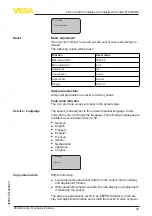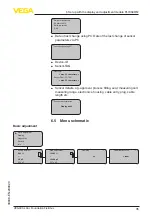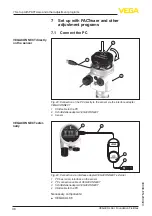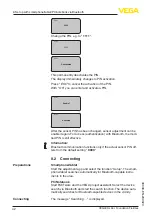
30
6 Set up with the display and adjustment module PLICSCOM
VEGACAL 66 • Foundation Fieldbus
30038-EN-200929
Max. adjustment
100.00 %
=
1000 pF
327.4 pF
1. Prepare the adjustment value for editing with
[OK]
. Move to the
selection window with
[OK]
.
Min. adjustment
Accept current measured
value?
Accept?
Edit?
2. Accept the current measured value or move to the editing window
with "Edit". To edit, set the cursor to the requested position with
[->]
. Set the requested % value with
[+]
and save with
[OK]
. The
cursor jumps to the capacitance value.
3. Enter the current capacitance value in pF (displayed below) for
the full vessel corresponding to the percentage value.
4. Save the settings with
[OK]
.
To suppress fluctuations in the measured value display, e. g. caused
by an agitated medium surface, a damping can be set. This time can
be between 0 and 999 seconds. Keep in mind that the reaction time of
the entire measurement will then be longer and the sensor will react
to measured value changes with a delay. In general, a period of a few
seconds is sufficient to smooth the measured value display.
Damping
0 s
Enter the requested parameters via the appropriate keys, save your
settings and jump to the next menu item with the
[->]
key.
A linearisation is necessary for all vessels in which the vessel volume
does not increase linearly with the level - e.g. in a horizontal cylindri
-
cal or spherical tank - and the indication or output of the volume is
required. Corresponding linearisation curves are preprogrammed for
these vessels. They represent the correlation between the level per-
centage and vessel volume. By activating the appropriate curve, the
volume percentage of the vessel is displayed correctly. If the volume
should not be displayed in percent but e.g. in l or kg, a scaling can be
also set in the menu item "
Display
".
Linearisation curve
Linear
Enter the requested parameters via the appropriate keys, save your
settings and jump to the next menu item with the
[->]
key.
Basic adjustment - Damp-
ing
Basic adjustment - Lin-
earization curve
















































